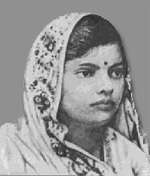Subhadra Kumari Chauhan
| Subhadra Kumari Chauhan सुभद्रा कुमारी चौहान | |
|---|---|
 Subhadra Kumari Chauhan | |
| Born |
16 August 1904 Allahabad, United Provinces of Agra and Oudh, British India |
| Died |
15 February 1948 (aged 43)[1] Seoni, Central Provinces and Berar, India |
| Occupation | Poet |
| Nationality | Indian |
| Period | 1904-1948 |
| Genre | Poetry |
| Subject | Hindi |
Subhadra Kumari Chauhan (16 August 1904[2][3] – 15 February 1948) was an Indian poet famous for Hindi poems composed primarily in Veer Ras, one of the nine Ras' of Hindi poetry (translation: Flavour/Subgenre). One of her most popular poems is Jhansi ki rani (about the courageous Queen of Jhansi).[4]
Early life
Born in Nihalpur village in Allahabad District, Uttar Pradesh. She initially studied in the Crosthwaite Girls' School in Allahabad and passed the middle-school examination in 1919. After her marriage with Thakur Lakshman Singh Chauhan of Khandwa in the same year, she moved to Jubbulpore (now Jabalpur), CP.[5]
Family
She married Thakur Lakshman Singh Chauhan of Khandwa in 1919 when she was sixteen with whom she had five children.
Career
In 1921, Subhadra Kumari Chauhan and her husband joined Mahatma Gandhi's Non-Cooperation Movement. She was the first woman Satyagrahi to court arrest in Nagpur and was jailed twice for her involvement in protests against the British rule in 1923 and 1942.[6]
Writing career
Chauhan has authored a number of popular works in Hindi poetry. Her most famous composition is Jhansi Ki Rani, an emotionally charged poem describing the life of Rani Lakshmi Bai. The poem is one of the most recited and sung poems in Hindi literature. An emotionally charged description of the life of the queen of Jhansi(British India) and her participation in the 1857 revolution, it is often taught in schools in India.[7] A popular stanza from it reads thus:
बुंदेले हरबोलों के मुँह हमने सुनी कहानी थी, खूब लड़ी मर्दानी वह तो झाँसी वाली रानी थी।।[8]
Translation: "How valiantly fought she, like a man / The Rani of Jhansi / On every parapet a gun she set / Raining fire of hell / How well like a man fought the Rani of Jhansi / How valiantly and well!"[9]
This and her other poems, Veeron Ka Kaisa Ho Basant, Rakhi Ki Chunauti, and Vida, openly talk about the freedom movement. They are said to have inspired great numbers of Indian youth to participate in the Indian Freedom Movement. Here is the opening stanza of Jhansi ki Rani:
Original Hindi text of one of the ten stanzas:
सिंहासन हिल उठे राजवंशों ने भृकुटी तानी थी,
बूढ़े भारत में भी आई फिर से नयी जवानी थी,
गुमी हुई आज़ादी की कीमत सबने पहचानी थी,
दूर फिरंगी को करने की सबने मन में ठानी थी।
चमक उठी सन सत्तावन में, वह तलवार पुरानी थी,
बुंदेले हरबोलों के मुँह हमने सुनी कहानी थी,
खूब लड़ी मर्दानी वह तो झाँसी वाली रानी थी।।
Roman transliteration using ITRANS:
sinhasan hil uthe, rajavanshon ne bhrikuti tani thi,
boodhhe bharat mein bhi aayi, phir se nayi jawaani thi,
gumi hui azadI ki keemat sab ne pahachani thi,
door firangi ko karne ki sab ne mann mein thani thi.
chamak uthi san sattawan mein, woh talwaar puraani thi,
bundele harbolon ke munh ham ne sunI kahani thi,
khoob ladi mardani woh to jhansI wali rani thi.
English translation:
The thrones shook and royalties scowled
Old India was re-invigorated with new youth
People realised the value of lost freedom
Everybody was determined to throw the foreigners out
The old sword glistened again in 1857
This story we heard from the mouths of Bundel bards
Like a man she fought, she was the Queen of Jhansi
Subhadra Kumari Chauhan wrote in the Khariboli dialect of Hindi, in a simple, clear style. Apart from heroic poems, she also wrote poems for children. She wrote some short stories based on the life of the middle class too.
Death
She died in 1948 in a car accident near Seoni M.P. on her way back to Jabalpur from Nagpur, the then capital of CP, where she had gone to attend the assembly session. She was a member of the legislative assembly of the state.
Memorials
The ICGS Subhadra Kumari Chauhan,[10] an Indian Coast Guard ship, was named for the poet.[1] The government of Madhya Pradesh placed a statue of Subhadra Kumari Chauhan before the Municipal Corporation office of Jabalpur. On August 6, 1976, India Posts released a postage stamp to commemorate her.[11]
Works
Collections of poems
- "Khilonewala"
- Tridhara, Puri Tarawa se chhodo
- Mukul (1930)
- Yeh Kadamb Ka Ped
These anthologies consist some of the well-known poems like Jhansi ki Raani, Veeron Ka Kaisa Ho Basant and Yeh Kadamb Ka Ped.
- Seedhe-Saade Chitra (1946)
- Seedhe-saade Chitra(1946)
- Mera naya bachpan(1946)
Bikhare moti (1932) Jhansi ki rani
References
- 1 2 "Biography of Subhadra Kumari Chauhan". https://allpoetry.com. All poetry. Retrieved 27 June 2017. External link in
|website=(help) - ↑ http://www.oxforddnb.com/templates/article.jsp?articleid=97283
- ↑ http://www.bharatdarshan.co.nz/author-profile/47/subhadrakumari-chauhan.html
- ↑ Rajaswi, M.I. (26 October 2016). Rashtrabhakt Kavyitri Subhadra Kumari Chauhan (Hindi) (1 ed.). New Delhi: Prabhat Prakashan. ISBN 978-9384344375.
- ↑ Chauhan, Subhadra Kumari (1 January 2012). Subhadrakumari Chauhan Ki Sampoorna Kahaniyan (Hindi Edition). New Delhi: Rajpal & Sons.
|access-date=requires|url=(help) - ↑ "Biography of Subhadra Kumari Chauhan". www.bharatdarshan.co.nz. Bharat Darshan. Retrieved 27 June 2017.
- ↑ "Poems of Bundelkhand". www.bundelkhand.in. Bundelkhand.In. Retrieved 27 June 2017.
- ↑ Chauhan, Subhadra Kumari. "Jhansi ki rani". www.poemhunter.com. Poem hunter. Retrieved 27 June 2017.
- ↑ Meyer, Karl E. & Brysac, Shareen Blair (1999) Tournament of Shadows. Washington, DC: Counterpoint; p. 145
- ↑ http://www.thehindu.com/todays-paper/tp-national/india-pakistan-plan-hotline-on-maritime-security/article3154123.ece
- ↑ http://www.stampsathi.in/php/public/stamps-gallery.php?page=71
- Nalini Natarajan, Emmanuel Sampath Nelson (1996). Handbook of Twentieth-century Literatures of India. Greenwood Publishing Group. ISBN 0-313-28778-3. by Natarajan, N.
External links
| Wikisource has original text related to this article: |